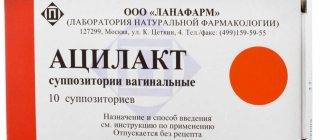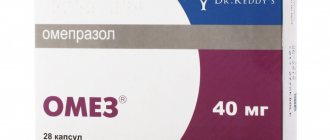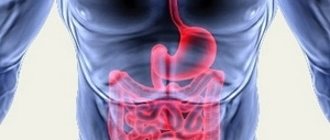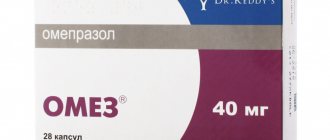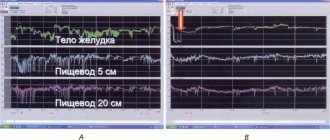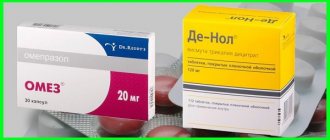How does Omez work?
Omez is a popular drug for the treatment of gastritis with high acidity and a number of other pathologies of the upper gastrointestinal tract. The medicine belongs to inhibitors of specific enzymes - the so-called proton pump, the working substance is omeprazole. Available in the form of capsules, the body is light purple, the cap is yellow, there is a special marking with the Latin name of the drug.
Omez is available in two dosages - 20 and 40 mg.
The formative substances in the capsules are meglumine, poloxamer, mannitol, dyes and a number of others. The price for a package of 28 capsules 40 mg is 290 rubles. The active substance inhibits the work of proton pump enzymes, which are present in the parietal cells of the membrane.
As a result, the release of hydrochloric acid decreases, since the final stage of the process is disrupted.
The pharmacodynamic characteristics of the drug are as follows:
- the action develops in 30-40 minutes and lasts up to a day;
- the highest efficiency is recorded after 2 hours;
- after completion of treatment, the activity of the proton pump is restored within 4 days;
- the drug is excreted with the participation of the liver; after processing, several inactive compounds are formed.
Since in liver failure and in old age the rate of drug elimination increases, adjustment of dosage and order of administration is necessary in these categories of patients.
Omez
The drug omez belongs to the pharmacological group of proton pump inhibitors and is used to correct all kinds of dyspeptic phenomena against the background of increased gastric secretion of hydrochloric acid. The international nonproprietary name (INN) of this drug (as well as the active substance included in its composition) is called “omeprazole”. Here it would be appropriate to provide readers with a brief explanation regarding the names of medicines, because To the average consumer uninitiated in these sacraments, all this may seem like Chinese literacy. So, if we don’t touch on the chemical name, which even a pharmaceutical chemistry teacher is unlikely to read without hesitation, then any drug has two names: INN (written on the packaging in a smaller font) and the trade name. The first is issued by the national pharmacopoeial committee or a special WHO committee. This name is not exclusive and can be used by any manufacturer without the risk of being dragged through the courts. As for the trade (brand) name, it is assigned to a specific drug by its manufacturer and cannot be produced by anyone else without the appropriate permission from him. That is, the trade name, by definition, is a guarantee of the quality of the drug. One of these brands is the Indian drug Omez.
Omez inhibits the activity of the enzyme H+/K+-ATPase, due to which the parietal cells of the gastric mucosa “throw out” chlorine and hydrogen ions.
By interfering with the work of this enzyme, the drug blocks the final stage of hydrochloric acid synthesis in the lumen of the stomach. The result of this is a pronounced decrease in the production of this substance, which gives gastric juice an aggressively acidic character. Omez is a prodrug, i.e. It is not activated immediately upon entry into the body, but while already in the acidic environment of the secretory tubules of the parietal cells of the gastric mucosa. The strength of the drug is directly dependent on the dose used. The time range for the onset of the antisecretory effect lies between 1 and 2 hours after taking a single (20 mg) dose of the drug. During the day, the secretion of hydrochloric acid under such conditions will be suppressed by half. To quickly and effectively suppress gastric secretion during the day and night, it is enough to take a single dose of omez once a day. The peak of its effect with this frequency of administration is reached on the 4th day after the start of treatment and subsides 3-4 days after discontinuation of the drug.
For those patients who, for various reasons, are not suitable for oral administration of omez or who suffer from severe forms of erosive and ulcerative lesions of the digestive tract, a dosage form for intravenous administration in the form of infusions has been developed. The daily dose of the drug in such cases is 40 mg.
Instructions for use of the medicine
WE RECOMMEND THE ARTICLE!
The enzyme preparation Enzistal helps with indigestion. Read more >>
The remedy is most often recommended for gastritis and peptic ulcers, both for treatment and for the prevention of exacerbations. What else does the drug help with? Indications include various disorders of the stomach and esophagus caused by increased acidity:
- GERD, or gastroesophageal reflux disease, including complicated by reflux esophagitis;
- chronic atrophic gastritis with high acidity;
- erosive gastritis;
- mixed gastritis;
- duodenitis;
- erosion, duodenal ulcer;
- idiopathic increase in acidity in the stomach (idiopathic hypersecretion);
- peptic ulcer, ulcer due to stress;
- ulcer, gastritis, erosion caused by taking anti-inflammatory drugs;
- systemic mastocytosis.
Omez tablets also help against infection - they help eliminate Helicobacter pylori, therefore they are prescribed in complex therapy along with antibiotics. The medicine is also given to patients with chronic pancreatitis - it has been proven that a course of treatment leads to an improvement in the functional state of the pancreas.
How to take for gastritis?
With gastritis, an inflammatory reaction occurs on the walls of the stomach. This condition can progress to the stage of peptic ulcer disease if the acidity of the secretion (hydrochloric acid) is not controlled in a timely manner. Omez is prescribed for these purposes. Since the damage is still minor and no other pathologies are observed, a prophylactic dose is used. The following recommendations for use apply:
- The medicine is drunk only 30 minutes before meals, it is forbidden to use it during or after meals, as the effect will not occur;
- use 20 mg 2 times a day or 40 mg 1 time a day;
- therapy continues for 8 weeks, then take a break;
- laboratory and instrumental tests are performed after completion of treatment; if gastritis persists, the course of therapy is repeated.
If the dosage is exceeded, the production of hydrochloric acid is significantly reduced. This complicates the digestion process, which is why gastritis will not go away, but will only get worse. If the dose is insignificant, the inflammatory process in the stomach will also develop and there will be no effect. Therefore, it is better to find out about the required concentration of the substance from your doctor after gastroscopy.
Instructions - use of Omez
The medicine should be taken 30 minutes before meals. It is not bitten into pieces or chewed, but the capsules are swallowed whole, washed down with water (a glass or half a glass). If you are unable to swallow the medicine, you can open the capsule, pour the granules into water, and take them orally. Do not dilute the medicine with carbonated drinks.
Storing the solution is unacceptable - it must be drunk immediately after preparation.
There are recommendations on dosage and duration of the course of taking the drug. The drugs Omez-D and Insta have their own dosage regimen and separate instructions for use. Omez is taken as follows:
- Ulcer without an infectious component
. Drink 20 mg once a day for a month. It is possible to repeat the course if the ulcer has not healed. In severe cases, take 20 mg (morning, evening) for up to 8 weeks. - Erosion, duodenal ulcer
. Take 20 mg in the morning for 14 days; after re-examination, it is possible to extend the course for the same period. - GERD
. The dose varies up to 4 capsules of 20 mg/day, depending on the complexity of the disease. The duration of treatment is from 4-8 weeks to lifelong. Maintenance therapy is possible for up to 25-50 weeks.
For the treatment of Helicobacter pylori, the drug is taken once a day, 40 mg in the morning, the duration depends on the general eradication scheme - 1-2 weeks. For hypersecretory conditions, take 60-120 mg of medication in 3 doses.
Omez D
Omez ® D
(lat.
Omez D
) - an antiulcer drug that reduces acidity in the upper gastrointestinal tract with a complex mechanism of action:
- reduces the production of hydrochloric acid in the parietal cells of the stomach, for which omeprazole, which is a proton pump inhibitor, is responsible
- stimulates gastric peristalsis, promoting the rapid movement of aggressive stomach contents into the duodenum, as well as increasing the tone of the lower esophageal sphincter, preventing the entry of stomach contents into the esophagus, for which domperidone, which is a prokinetic agent, is responsible
The combined use of prokinetics and drugs with antisecretory effects significantly increases the effectiveness of therapy for patients with GERD with symptoms of functional dyspepsia. This combination allows for bidirectional acid suppressive and prokinetic effects of the drug, which significantly increases the effectiveness of treatment and patient compliance. Omez D can be prescribed 1 capsule 2 times a day for 2-4 weeks to patients with GERD with symptoms of functional dyspepsia during the period of maintenance therapy for the disease (Yakovenko E.P. et al.).
General information
Omez D is a prescription medicine
.
According to the pharmacological index, Omez D belongs to the group “Proton pump inhibitors in combinations”. According to ATC - to the group “A02 Drugs for the treatment of diseases associated with acidity disorders”, and has the code “A02BX Other antiulcer drugs and drugs for the treatment of gastroesophageal reflux”. In Russia, two more drugs with similar names and similar (but not identical) pharmaceutical effects are approved for use:
- “Omez DSR” is a drug that has the same two active ingredients as Omez D: omeprazole and domperidone, but the Omez DST capsule contains these substances in the form of granules: enteric-coated omeprazole granules and extended-release domperidone granules
- "Omez Insta" is a drug with a combined mechanism of action, containing, in addition to omeprazole, sodium bicarbonate
- “Omez” is “pure” omeprazole, which, unlike Omez Insta, Omez D and Omez DSR, does not contain sodium bicarbonate or domperidone.
Manufacturer Omeza D:
Dr. Reddy's Laboratories Ltd, India.
Publications for healthcare professionals addressing the use of Omez D in the treatment of gastroenterological diseases
- Sheptulin A.A. Chronic gastritis and functional dyspepsia: is there a way out of the deadlock? // Effective Pharmacotherapy. 2012. No. 1. P. 59–61.
- Lapina T.P., Bueverov A.O. Bitterness in the mouth: interpretation of a gastroenterologist // Clinical perspectives of gastroenterology, hepatology. 2013. No. 3.
On the website gastroscan.ru
in the literature catalog there is a section “Omeprazole”, containing professional medical articles discussing the treatment of diseases of the gastrointestinal tract with omeprazole, as well as a section “Prokinetics”, containing articles on the use of prokinetics in the treatment of diseases of the gastrointestinal tract.
Omez D has contraindications, side effects and application features. Consultation with a specialist is necessary.
Back to section
How to take - before or after meals?
Omez is based on the active ingredient omeprazole. It effectively reduces the secretion of hydrochloric acid, therefore the patient’s well-being improves with peptic ulcers of the stomach and duodenum, gastroesophageal reflux, and hypersecretion. But a beneficial effect occurs only with proper use. Therefore, it is recommended to adhere to the following instructions for use:
- consumed only 30 minutes before meals to act on the proton pump of the stomach before food arrives;
- the capsule of the drug is large enough, so if it is difficult to swallow it whole, you can mix the contents with liquid (juice, water) and drink it completely;
- The dosage varies depending on the diagnosis; 20 to 120 mg per day is prescribed to control the production of hydrochloric acid.
If the patient takes the drug during or after meals, the effect will be significantly weakened. Hydrochloric acid will begin to be produced as usual, increasing the inflammatory reaction in the stomach and duodenum. Therefore, it is recommended to use the product only before meals.
Omez 10 mg
You should consult your doctor before taking Omez if you are being treated with one or more of the medications listed in this section.
A decrease in the secretion of hydrochloric acid in the stomach during treatment with omeprazole and other proton pump inhibitors can lead to a decrease or increase in the absorption of other drugs, the absorption of which depends on the acidity of the environment.
Substances with pH-dependent absorption.
Like other drugs that reduce gastric acidity, treatment with omeprazole may lead to decreased absorption of ketoconazole, itraconazole, posaconazole, erlotinib, iron supplements and cyanocobalamin. Their co-administration with omeprazole should be avoided.
Digoxin
The bioavailability of digoxin when used simultaneously with omeprazole increases by 10% (adjustment of the digoxin dosage regimen may be required). Caution should be exercised when these drugs are used concomitantly in elderly patients.
Clopidogrel
According to the results of the studies, an interaction was noted between clopidogrel (loading dose 300 mg, maintenance dose 75 mg/day) and omeprazole (80 mg/day orally), which reduces the exposure of the active metabolite of clopidogrel and reduces the inhibition of platelet aggregation. The observed effect is likely due to the inhibitory effect of omeprazole on the CYP2C19 isoenzyme. Therefore, the simultaneous use of omeprazole and clopidogrel should be avoided.
Antiretroviral drugs
An increase in pH during omeprazole therapy may affect the absorption of antiretroviral drugs. Interaction at the level of the CYP2C19 isoenzyme is also possible. When omeprazole is co-administered with certain antiretroviral drugs, such as atazanavir and nelfinavir, a decrease in their serum concentrations is observed during omeprazole therapy. When used simultaneously with omeprazole, the area under the concentration-time pharmacokinetic curve of omeprazole decreases by 75%.
Dose adjustment of omeprazole when used concomitantly with inhibitors of CYP2C19 and/or CYP3A4 isoenzymes may be required in patients with severe hepatic impairment in case of long-term use of omeprazole. With short-term joint use, dose adjustment is not required due to the good tolerance of high doses of omeprazole.
Inducers of CYP2C19 and CYP3A4 isoenzymes
Inducers of the CYP2C19 and CYP3A4 isoenzymes, such as rifampicin, preparations of St. John's wort (Hypéricum perforatum), when used together with omeprazole, can lead to a decrease in the concentration of omeprazole in the blood plasma by accelerating the metabolism of omeprazole.
No effect on metabolism
Co-administration of omeprazole with amoxicillin or metronidazole does not affect the concentration of omeprazole in the blood plasma.
No clinically significant interaction of omeprazole with metoprolol, phenacetin, estradiol, budesonide, diclofenac, naproxen, piroxicam, S-warfarin has been established.
There was no effect of omeprazole on antacids, theophylline, caffeine, quinidine, lidocaine, propranolol, ethanol.
Prohibitions in treatment and “side effects”
The product is contraindicated in children over 18 years of age (Omez-Insta is indicated in childhood), pregnant women, breastfeeding women, and those with allergies or hypersensitivity. If the function of the hepatobiliary system is insufficient, the dosage is set separately depending on the condition of the organ. In old age, use with caution; the dose usually does not exceed 20 mg/day.
Before treatment with Omez, it is important to conduct a full examination - the medicine may cover the symptoms of tumors.
Serious side effects are very rare. Sometimes various allergic reactions occur, constipation or diarrhea, nausea, abdominal pain, and in some patients AST and ALT levels of the liver increase. Possible reversible taste disturbance, development of stomatitis, colitis, hepatitis. There are headaches, dizziness, sleep disturbances, changes in mood and behavior.
Does it cause stomach cancer?
Long-term use of Omez does not cause stomach cancer. However, its use leads to an improvement in clinical symptoms, so the appearance of a malignant neoplasm can be masked. Before prescribing the medicine, it is recommended to conduct gastroscopy and other examinations to identify the disease.
Omez cannot cause cancer. It only suppresses the secretion of gastric juice in order to eliminate the inflammatory process of the mucous membrane. If cancer forms on its own, it will progress without making the person feel worse. Therefore, it will not be possible to detect a malignant neoplasm in a timely manner. This is due to the following effects of Omez on the body:
- suppression of pain in the abdominal region;
- elimination of heartburn;
- normalization of digestive function.
These are the reactions that can occur in cancer. If they are noticed in time and examined, the disease can be identified. If symptoms are suppressed, only some patients will see a doctor for examination for medical examination.
Omez's analogs
| A drug | Compound | Price, rubles |
| Omeprazole | Omeprazole | 75 |
| Beret | Rabeprazole | 390 |
| Nolpaza | Pantoprazole | 210 |
| Control | Pantoprazole | 640 |
| Lancid | Lansoprazole | 340 |
| Ultop | Omeprazole | 130 |
What is better to choose Omez or Omeprazole, read in this article.
With long-term use, the drug causes an increase in bacterial colonies in the intestines, which may slightly increase the risk of developing intestinal infections. 5 days before examination for hormonally dependent tumors, the drug should be stopped.
In a number of patients, during long-term treatment (more than a year) with Omez, benign cysts appear in the gastrointestinal tract, which resolve on their own without ending therapy. In elderly patients, long-term treatment with drugs of this group may increase the risk of developing osteoporosis, so it is important to regularly take blood tests to determine the level of calcium, phosphorus, and vitamin D.
Ranitidine or Omez, which is better?
Ranitidine is a medicine based on the active substance of the same name. Reduces gastric secretion. Therefore, it is prescribed for gastric ulcers, reflux esophagitis, and diseases that cause increased secretion.
Omez is a drug based on omeprazole. The drugs have different active ingredients, but the mechanism of action and indications for use are identical. The contraindications for use are completely similar. The following differences are observed:
- Ranitidine has far fewer side effects than Omez;
- For children, Omez is approved for use only for gastroesophageal reflux; there is no data on Ranitidine, so its use is not recommended;
- in case of liver pathology, Omez is allowed, but its dose should not exceed 20 mg per day, since the active substance is metabolized in this organ;
- Omez can cause an overdose, which will cause arrhythmia, headache, dry mouth, and confusion.
Since the mechanisms of action of the drugs are identical, side effects are considered when choosing a drug. If the patient has contraindications to Omez, Ranitidine is chosen, and vice versa. During therapy, tests are taken to determine the effectiveness of therapy.
Omez® DSR (Omez® DSR)
There have been no specific studies of drug interactions between Omez® DSR and other drugs. The following drug interactions have been reported for certain medications.
Substances with pH-dependent absorption
Like other drugs that reduce gastric acidity, treatment with omeprazole may lead to decreased absorption of ketoconazole, itraconazole, posaconazole, erlotinib, iron supplements and cyanocobalamin. Their combined use with Omez® DSR should be avoided.
Antacid and antisecretory drugs
Cimetidine and sodium bicarbonate reduce the oral availability of domperidone.
Digoxin
The bioavailability of digoxin when used simultaneously with omeprazole increases by 10%. Caution should be exercised when using digoxin and Omez® DSR simultaneously in elderly patients. Co-administration of domperidone and digoxin does not change the concentration of the latter.
Clopidogrel
According to the results of the studies, an interaction was noted between clopidogrel (loading dose 300 mg, maintenance dose 75 mg/day) and omeprazole (80 mg/day orally), which reduces the exposure of the active metabolite of clopidogrel and reduces the inhibition of platelet aggregation. Therefore, the simultaneous use of clopidogrel and omeprazole at a dose of 80 mg per day should be avoided.
Antiretroviral drugs
An increase in pH during omeprazole therapy may affect the absorption of antiretroviral drugs. Interaction at the level of the CYP2C19 isoenzyme is also possible. In this regard, the combined use of Omez® DSR with antiretroviral drugs such as atazanavir and nelfinavir is contraindicated.
When used simultaneously with omeprazole, an increase in plasma concentrations of saquinavir/ritonavir is observed up to 70%, while the tolerability of treatment in patients with HIV infection does not deteriorate.
The suppressive effect of HIV protease inhibitors on the CYP3A4 isoenzyme may cause an increase in the concentration of domperidone when co-administered with Omez® DSR.
Tacrolimus
With the simultaneous use of omeprazole and tacrolimus, an increase in the concentration of tacrolimus in the blood serum was noted. It is necessary to monitor the creatinine clearance and the concentration of tacrolimus in the blood plasma when used together with Omez® DSR.
Methotrexate
Proton pump inhibitors may slightly increase plasma concentrations of methotrexate. When treated with high doses of methotrexate, you should temporarily stop taking Omez® DSR.
Drugs metabolized by the CYP2C19 isoenzyme
When used simultaneously with omeprazole, it is possible to increase the plasma concentration and increase the half-life of warfarin (R-warfarin), diazepam, phenytoin, cilostazol, imipramine, clomipramine, citalopram, hexobarbital, disulfiram, as well as other drugs metabolized in the liver with the participation of the CYP2C19 isoenzyme (may dose reduction of these drugs may be required). However, taking omeprazole 20 mg per day does not affect the concentration of phenytoin in the blood plasma in patients taking phenytoin for a long time. When using omeprazole in patients receiving warfarin or other vitamin K antagonists, monitoring of the international normalized ratio is necessary. At the same time, concomitant treatment with omeprazole at a daily dose of 20 mg does not lead to a change in coagulation time in patients taking warfarin for a long time.
Inhibitors of CYP2C19 and/or CYP3A4 enzymes
Concomitant use with inhibitors of CYP2C19 and/or CYP3A4 isoenzymes slows down the metabolism of omeprazole.
When omeprazole or domperidone is taken together with clarithromycin or erythromycin, the concentration of omeprazole, as well as the concentration of domperidone in the blood plasma increases.
The combined use of voriconazole and omeprazole leads to an increase in the area under the pharmacokinetic curve of omeprazole. Fluconazole, itraconazole, ketoconazole and voriconazole also increase plasma concentrations of domperidone.
The suppressive effect of HIV protease inhibitors on the CYP3A4 isoenzyme may cause an increase in the concentration of domperidone when co-administered with Omez® DSR.
Clinical experience and in vitro studies indicate that plasma concentrations of domperidone may be increased when strong CYP3A4 inhibitors such as calcium antagonists (diltiazem and verapamil), nefadosone and amiodarone are co-administered.
In addition, when taking amiodarone, or when taking domperidone together with ketoconazole, erythromycin, the QT interval may be prolonged (see section "Special Instructions").
Inducers of CYP2C19 and CYP3A4 enzymes
Inducers of the CYP2C19 and CYP3A4 isoenzymes, such as rifampicin, preparations of St. John's wort (Hypericum perforatum), when used together with omeprazole, can lead to a decrease in the concentration of omeprazole in the blood plasma by accelerating the metabolism of omeprazole.
Anticholinergic drugs
Anticholinergic drugs may counteract the effects of domperidone.
No effect on metabolism
Co-administration of omeprazole with amoxicillin or metronidazole does not affect the concentration of omeprazole in the blood plasma.
No clinically significant interaction of omeprazole with metoprolol, phenacetin, estradiol, budesonide, diclofenac, naproxen, piroxicam, S-warfarin has been established.
There was no effect of omeprazole on antacids, theophylline, caffeine, quinidine, lidocaine, propranolol, ethanol.
The use of domperidone while taking paracetamol or digoxin did not affect the level of these drugs in the blood.
Domperidone is compatible with the use of antipsychotic drugs (neuroleptics), dopaminergic receptor agonists (bromocriptine, L-dopa), as it inhibits their undesirable peripheral effects (nausea and vomiting) and does not affect their central effects.
What is better Nolpaza or Omez?
Omez is based on omeprazole. Nolpaza contains pantoprazole sodium sesquihydrate. The medicine reduces the production of hydrochloric acid and is suitable for combating Helicobacter pylori in complex therapy. But Nolpaza has significantly fewer indications for use:
- peptic ulcer of the stomach and duodenum;
- reflux esophagitis;
- Zollinger-Ellison syndrome;
- complex therapy for the spread of Helicobacter pylori.
If the patient has one of the diseases, it is better to use Nolpaza. It extremely rarely causes side effects; there are significantly fewer of them than with Omez. Nolpaza is contraindicated only for dyspepsia and malignant neoplasms of the gastrointestinal tract. It can be used in case of severe liver pathologies, but periodically a biochemical test is taken to detect transaminase activity.
Omez is more difficult for patients to tolerate. Side effects occur more frequently. But it can be used in children with reflux esophagitis to suppress stomach acid. Its indications for use are more expanded, so doctors prescribe the drug when Nolpaza is ineffective. For example, when using NSAIDs, preventing Mendelssohn syndrome.
Omez® D
Domperidone
Interactions with the following drugs may increase the risk of QT prolongation:
Contraindicated combinations: drugs that prolong the QT interval: class IA antiarrhythmic drugs (eg, disopyramide, hydroquinidine, quinidine), class III antiarrhythmic drugs (eg, amiodarone, dofetilide, dronedarone, ibutilide, sotalol), antipsychotics (eg, haloperidol, pimozide, sertindole), antidepressants (eg, citalopram, escitalopram), antibiotics (eg, erythromycin, levofloxacin, moxifloxacin, spiramycin), antifungals (eg, pentamidine), antimalarials (eg, halofantrine, lumefantrine), gastrointestinal drugs (eg, cisapride , dolasetron, prucalopril), antihistamines (eg, mechitazine, mizolastine), antineoplastic drugs (eg, toremifene, vandetanib, vincamine), other drugs (eg, bepridil, difemanil methylsulfate, methadone), strong CYP3A4 inhibitors (protease inhibitors, antifungals azole series, some antibiotics from the macrolide group (erythromycin, clarithromycin, telithromycin)).
Not recommended combinations: moderate CYP3A4 inhibitors (diltiazem, verapamil, some macrolide antibiotics).
Combinations that should be used with caution: drugs that cause bradycardia and hypokalemia, as well as azithromycin and roxithromycin.
Cimetidine, sodium bicarbonate, and other antacid and antisecretory drugs reduce the bioavailability of domperidone.
Anticholinergics may counteract the effects of domperidone.
Increase the concentration of domperidone in plasma: azole antifungals, antibiotics from the macrolide group, HIV protease inhibitors, nefazodone.
Domperidone is compatible with the use of neuroleptics, dopaminergic receptor agonists (bromocriptine, levodopa),
Omeprazole
When omeprazole is used together with some antiretroviral drugs, such as atazanavir and nelfinavir, a decrease in their plasma concentration is observed. In this regard, the combined use of omeprazole with atazanavir and nelfinavir is contraindicated.
With simultaneous use of omeprazole and saquinavir/ritonavir, an increase in saquinavir plasma concentrations was observed.
The bioavailability of digoxin when used simultaneously with omeprazole increases by 10% (adjustment of the dosage regimen may be required). Caution should be exercised when these drugs are used concomitantly in elderly patients.
With simultaneous use of omeprazole with clopidogrel, a decrease in the antiplatelet effect of the latter is observed. Therefore, the combined use of omeprazole and clopidogrel should be avoided.
Like other drugs that reduce gastric acidity, treatment with omeprazole may lead to decreased absorption of ketoconazole, itraconazole, posaconazole, erlotinib, iron supplements and cyanocobalamin. Their co-administration with omeprazole should be avoided.
When used simultaneously with omeprazole, it is possible to increase the plasma concentration and increase the half-life of warfarin, diazepam, phenytoin, cilostazol, imipramine, clomipramine, citalopram, hexobarbital, disulfiram, as well as other drugs metabolized in the liver with the participation of the CYP2C19 isoenzyme (a dose reduction of these drugs may be required ).
When methotrexate was co-administered with proton pump inhibitors, a slight increase in plasma methotrexate concentrations was observed in some patients. When treated with high doses of methotrexate, omeprazole should be temporarily discontinued.
With the simultaneous use of omeprazole and tacroliamus, an increase in the concentration of tacrolimus in the blood plasma was noted, which may require adjustment of its dose. When omeprazole is taken together with inhibitors of the CYP2C19 and CYP3A4 isoenzymes (such as clarithromycin, erythromycin, voriconazole), the concentration of omeprazole in the blood plasma increases.
Inducers of the CYP2C19 and CYP3A4 isoenzymes, such as rifampicin, preparations of St. John's wort (Hipericum perforatum), when used together with omeprazole, can lead to a decrease in the concentration of omeprazole in the blood plasma by accelerating the metabolism of omeprazole.
Co-administration of omeprazole with amoxicillin or metronidazole does not affect the concentration of omeprazole in the blood plasma.
There was no effect of omeprazole on antacids, theophylline, caffeine, quinidine, lidocaine, propranolol, ethanol.
